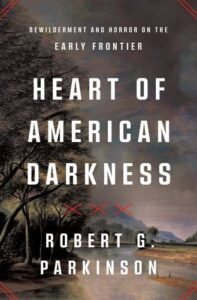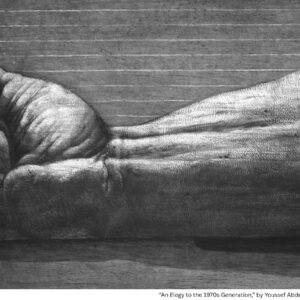
“Invasion is a Structure Not an Event.” On Settler Colonialism and Joseph Conrad’s Heart of Darkness
Robert G. Parkinson on Historicizing Imperial Encounters at Home and Abroad
“There is no initiation either into such mysteries. He has to live in the midst of the incomprehensible, which is also detestable. And it has a fascination, too, that goes to work upon him.”
–Heart of Darkness
*Article continues after advertisement
On the final day of April 1774, the Minerva was plying the waters of the Atlantic Ocean, headed for Boston. On board were London newspapers bearing the first news of England’s response to the Tea Party. Bostonians would soon learn that, as punishment, the Crown had decided to close the port, a step that would spark a civil war in the British empire. Hours before the Minerva’s lookout spied Boston Harbor, seven Native people crossed a smaller body of water as they traveled to a meeting that they hoped would prevent a similar breakdown in relations with colonial settlers. The party knew the trip put them in mortal danger and yet they went anyway; it’s what their family had done for more than four decades.
That family had negotiated relationships between Natives and colonists since the 1730s. So despite whatever apprehensions they might have had, they climbed into their canoes and let a tributary called Yellow Creek carry them about a mile down to the Ohio River. Today, they would have passed under Ohio Route 7 and a graffiti-covered railroad trestle right as they caught the big river’s course. Paddling against the current, they soon reached their destination, a small log cabin that sat just up from the eastern shore on a piece of ground known as Baker’s Bottom.
While we can acknowledge that white colonists possessed enormous power, not least in their sheer numbers, that alone does not explain imperial encounter.
The seven Natives—four men, two women, and a baby—were invited into the cabin’s front room, where a few colonists poured them drinks and allegedly launched into a conventional ceremony of keeping peace. Things were tense, but the alcohol helped. The two groups joked with one another. One of the colonial hosts had a British regimental uniform. As they all got a little tipsy, a Native man put on the red coat and paraded around the room. Someone proposed a shooting contest as a diversion and perhaps to further clear the air. Several went outside and identified a target. You go first, the white men told the Natives, and the latter fired, leaving themselves disarmed. The trap was sprung.
There were more than a dozen colonists hiding in the back room of the cabin. When the shooting started, the crouching, silent men leapt into action, running out into the yard, advancing on the unsuspecting Natives, who turned and sprinted for their canoes. Bullets took down one man, then another and another, spilling blood over the ground as acrid gunsmoke rose into the air. An elderly woman also fell. A second Native woman clutched her baby and ran for the water’s edge. When she realized escape was impossible, she turned and begged the men to spare the child’s life. She’s the daughter of a white man, the mother pleaded about her child, hoping that might convince them. They paused and allowed her to hand over the baby before shooting her in the face.
Three more Natives, worried about what might be happening across the way, had come looking for their relations. They were caught in the middle of the river when the colonists fired away, killing two of them, too. One, a woman, survived, but was gravely wounded and barely made it to the other side.
In all, eight Native people would perish in the horror at Yellow Creek on April 30, 1774. In contrast to many stories from America’s history about Native-European encounters, where we know little about the lives of half of the participants, in this case we know several of the victims well. We know their family biography. They were the family of Shickellamy, one of the most significant Iroquois leaders of the mid-eighteenth century.
His importance lay in the role he had played as an ambassador for his people: decades before, the Six Nations tasked him with checking white colonists’ desires for more and more land along a different river, the Susquehanna, east of the Ohio Valley. He befriended the man who was in many respects his opposite, James Logan, Pennsylvania’s agent tasked with satiating colonists’ thirst for land. Shickellamy honored his friend and colleague by giving two of his sons the name Logan.
Those boys would become Native negotiators in their own right. The Shickellamys were one of the most prominent political families in North America in the middle of the eighteenth century. They had tried for a generation to forge deals between colonists and Natives. They had participated in and shaped many of the most consequential events in the history of colonial America. Despite their efforts, they had largely failed and now nearly all of them were dead. Shickellamy’s wife, youngest son, and a daughter were among the slain at Yellow Creek.
*
The interpretative paths we have constructed to help guide us through the baffling, bewildering forests of early America struggle with horrific scenes like these. One of the most prominent of these paths was blazed by a thirty-two-year-old historian named Frederick Jackson Turner. Delivered as an address in 1893 at an exposition commemorating the four hundredth anniversary of Columbus’s voyage to the New World, Turner’s “The Significance of the Frontier to American History” is widely considered to be among the most influential pieces of writing about American history.
How Turner reached his conclusions has become its own legend. As the story goes, Turner gathered the ideas that would become his “frontier thesis” after reading the results of the 1890 census. The bureaucrats in the Census Office proclaimed that the frontier, a line of “settlement” that had steadily advanced across the continent throughout the eighteenth and nineteenth centuries, was now closed; it was a relic of the past. Turner read this report with alarm. It compelled him to investigate what effect the frontier had had on the United States.
In “The Significance of the Frontier,” Turner declared that the process of “perennial rebirth, this fluidity of American life, this expansion westward with its new opportunities … furnish the forces dominating American character.” It was the secret to what made the United States different from and better than every other nation. For Turner, incidents like Yellow Creek were aberrations perpetrated by a “line of scum that the waves of advancing civilization bore before them.” Unfortunate episodes such as these were merely a small part of a larger glory, of a world-historical dynamic that had made America—and Americans—great.
Since the 1940s, scholars have challenged Turner’s thesis. They have pointed out all of the men and women whom Turner left out of his fabulous tale. Critics have especially taken issue with his notion of an advancing frontier line, using other words that emphasized space over time, place over process. Focusing on regional differences, historians have presented evocative and powerful accounts of how colonists and Natives encountered one another on middle grounds, native grounds, borderlands, and bordered lands.
Each of these terms offered a new analysis of Native-colonial encounter, focusing on who dictated political, economic, and cultural terms and how power ebbed and flowed. They contend that geography matters: what happened in the region they are studying could only have done so in that specific spot. This is by design; a rejection of Turnerian meta-narratives.
More recently, scholars looking to interpret encounter between Native peoples and colonists have relied on the concept of “settler colonialism.” Developed largely by Australian scholars writing about what happened to Indigenous peoples there, the concept of settler colonialism has been used to argue that European settlers in the Americas did not simply take land and resources from Indigenous peoples but eliminated them after the fact by destroying their history and discrediting their way of life.
Settler colonialism posits a “double dispossession”: Europeans did more than invade Native lands—they occupied them. For theorists of settler colonialism, incidents like Yellow Creek are all too easy to understand; what happened to the eight Natives at Baker’s Bottom was not only predictable, but an inevitable and unsurprising part of the conquest of North America.
At its core, settler colonialism represents a reversion back to a focus on time. It is another process argument, one that has an oddly Turnerian quality to it. Although its claims come from precisely the opposite track than Turner’s celebration of pioneers, settler colonialism has a logic, a thrust, a teleology, too. Just as Turner’s tale had frontiersmen laying the foundation of American greatness through the trials of taming the West, historians who subscribe to settler colonialism tell us the double dispossession—the destruction of Native America—was also inescapable.
“Invasion is a structure not an event,” Australian historian Patrick Wolfe, the leading theorist of settler colonialism, has argued. It is a process that “pursues a specific end point,” another has written. Advocates of settler colonialism look back from the perspective of the modern world and interpret the past nearly as confidently as Turner did.
The confidence that comes from knowing how things actually did turn out is an inherent hazard on all these interpretive paths. While we can acknowledge that white colonists possessed enormous power, not least in their sheer numbers, that alone does not explain imperial encounter. Either dismissing the horror of Yellow Creek or expecting it doesn’t tell us how that particular event happened, why it mattered, or what legacies it left.
Interpretations that leave little room for contingency, choice, biography, and even irrationality and misperception ultimately do a disservice to all the people who lived through imperial encounter, and to ourselves as we try to make sense of its consequences. Anishinaabe historian Michael Witgen has argued that, even in the twenty-first century, “the settler colonial project of the United States is not complete but remains an ongoing process.” That such uncertainties remain today only underscores the ambiguous nature of power in the bewildering Ohio Valley two hundred fifty years ago.
*
Perhaps the problem is we are “seeing” things wrong. Maybe it would help if we went back to the 1890s and started over again. In that decade there was another writer of Turner’s generation who developed his own vision of imperial encounter. The path he laid might lead toward a better understanding of what happened in the early American backcountry.
Józef Teodor Konrad Korzeniowski was born in 1857, four years before Turner, in what is now Ukraine, to a family of Polish nationalists who had also lived through an imperial conquest. After Russian officials exiled his father for plotting against the czar, the young family fell apart. Both parents died of tuberculosis before Józef was eleven. He eventually fled to the sea, where he signed on with the merchant marine at age sixteen, and began to call himself Joseph Konrad.
Konrad’s years afloat coincided almost exactly with the “scramble for Africa” in the final quarter of the nineteenth century, which saw European powers race to colonize that continent. At age thirty-two, with “large black eyes,” “a determined chin,” and a “thick, well-trimmed, dark brown mustache,” Konrad spent part of 1890 in central Africa, on the Congo River, witnessing imperialism. What he encountered led him to see the process of taming the wilderness vastly different from Turner.
When he escaped from the Congo—he almost didn’t survive, he was so ill—he decided to give up his career as a sailor and become a writer. Anglicizing his last name to Conrad, his first novel, Almayer’s Folly, would appear two years after Turner’s address to the Columbian Exposition. In 1899, Blackwood’s Magazine serialized a story Conrad had written about his harrowing months in central Africa. Three years later, that novella would be published as Heart of Darkness. It would come to be regarded as an essential book about European imperialism and what the exploitation of Africa revealed about human nature.
It is antithetical to the historian’s job—if not simply a heresy—to say that we sometimes cannot confidently sort out what happened in the past.
Conrad’s vision of imperial encounter, on its face, would seem to please a theorist of settler colonialism. There is, after all, no heroic mission in Heart of Darkness; there is no triumph. “The conquest of the earth,” Conrad’s narrator says, “which mostly means the taking it away from those who have a different complexion or slightly flatter noses than ourselves, is not a pretty thing when you look into it too much.” Imperialism is not an intrepid adventure that brings out humanity’s best. It is a horror.
In Heart of Darkness, the reader doesn’t find sturdy Turnerian pioneers but rather haunted white men surrounded by severed heads on pikes. But stopping there would miss much of Conrad’s point. It is not enough to simply describe the violence and exploitation of imperialism. The achievement of Conrad’s novella is not a “thesis” about imperialism but a description of how people caught up in it encountered and experienced the chaos it produced.
It is antithetical to the historian’s job—if not simply a heresy—to say that we sometimes cannot confidently sort out what happened in the past. Although it is the historian’s remit to make sense of the people and events that came before, to delineate causes, explain origins, and measure consequences, there are instances when our imposition of order on the past misleads. Not only that, but historians’ sweeping interpretations can become forces in their own right.
Turner’s thesis is perhaps the best American example of how a proposition about the past can shape the future. “No myth has become more powerful, more invoked by more presidents, than that of pioneers advancing across an endless meridian,” one scholar has recently written. “Onward and then onward again.” Those who came after Turner transformed his thesis into an “ideology of limitlessness,” and used it to justify American power all over the world. Settler colonialism, by contrast, suggests that the United States should reconsider its global ambitions and come to terms with how it became a superpower in the first place: via the conquest of a continent and the people who lived in North America. Turner’s interpretation celebrates; settler colonialism condemns.
Heart of Darkness is useful because it undermines the historians’ project of confidently knowing or being able to account for what happened in confusing places like the ones Conrad saw in the Congo. When he reflected on the consequences of empire, Conrad saw no logic or teleology. He saw mayhem. There is no surety in Heart of Darkness; everything that happens in the novella suggests absurdity and bewilderment. Upon arriving in the Congo, the book’s narrator, Charles Marlow, finds mountains being blasted apart to make room for railroads that go nowhere. He watches “incomprehensible” European gunships lobbing shells at “enemies” who cannot be seen or even identified. He recoils as he stumbles upon a “grove of death,” an idyllic place right next to the deafening Congo rapids where Native people are worked to the edge of life because they have been judged “criminals,” though they have committed no offense.
A Belgian trading company has sent Marlow to find and bring home a man named Kurtz, and he scoffs when he first sees that Kurtz, the German word for “short,” is tall and lanky. Nothing is what it seems in this bizarre world. Marlow’s perception is marred by fog or smoke or flickering shadows, and he can’t believe the things his eyes see. As one literary scholar has stated, “moments of intense bewilderment occur so frequently in Conrad’s fiction that they seem less unusual than customary.” This is especially true of Heart of Darkness.
Marlow becomes an observer of this bewilderment, registering the strangeness around him. His purpose, as a character, is to document and explicate for the reader the senselessness of empire. We are supposed to be put ill at ease by the absurdity and cruelty of the imperial Congo. Bewilderment, for Marlow, is a state of mind; it is a way of existing in this upside-down world.
But imperialism has even more insidious effects on those who fully engaged in it. The man Marlow has been sent to the Congo to find operates on a deeper level of bewilderment. Kurtz is a veteran of empire, and it has turned him into a chaos agent. Marlow is sent to retrieve Kurtz because the latter no longer seems to work for anyone except himself. Kurtz has grasped the power of bewilderment and is now exploiting it to his own benefit. In Kurtz’s hands, it is no longer just a description of what imperial encounter does to the world but rather a weapon to be brandished. Bewilderment, for Kurtz, is a state of play; it is a way of making this upside-down world work to one’s advantage.
In the 1890s, Conrad faced imperialism’s bewildering effects. He watched how some Europeans tried to sow even more confusion to maximize their own rewards, a strategy that further compounded the violence. He tried to render it the best way he knew, through fiction, and the resulting sentences evoked the incomprehension that is inherent to imperial encounter.
__________________________________

Excerpted from Heart of American Darkness: Bewilderment and Horror on the Early Frontier by Robert G. Parkinson. Copyright © 2024. Available from W.W. Norton & Company.
Robert G. Parkinson
Robert G. Parkinson is associate professor of history at Binghamton University. He is the author of The Common Cause and Thirteen Clocks. He lives in Charles Town, West Virginia.












